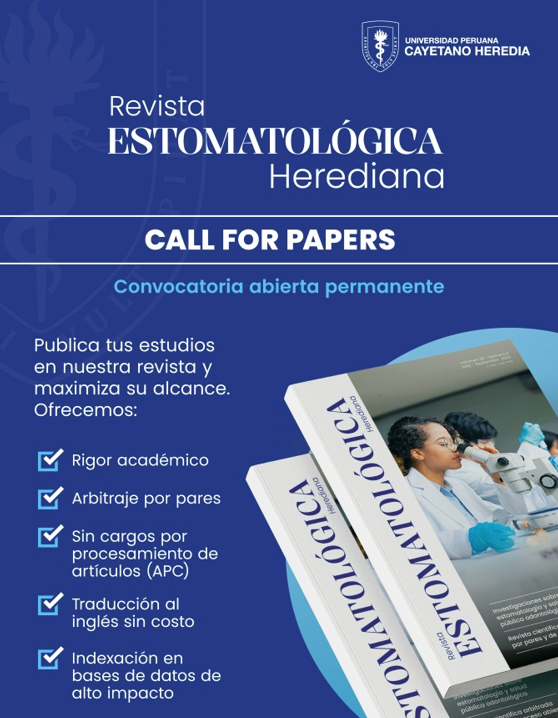Cementos a base de silicato de calcio: factor clave en el éxito del recubrimiento pulpar directo. Revisión de la literatura
DOI:
https://doi.org/10.20453/reh.v32i1.4183Palabras clave:
Cemento de silicato, recubrimiento de la pulpa dental, resultado del tratamientoResumen
Tradicionalmente, el hidróxido de calcio (HC) era considerado el material de elección para el recubrimiento pulpar directo (RPD); pero esto ha cambiado con los años debido a las distintas desventajas que presenta. Los cementos a base de silicato de calcio (CSC) tienen propiedades ventajosas al compararlos con el HC como: bioactividad, biocompatibilidad, menor tiempo de fraguado, capacidad de sellado y resistencia, por lo que son usados en una variedad de procedimientos endodónticos, entre ellos el RPD. El presente artículo de revisión recopila información a partir de la búsqueda manual de artículos originales de investigación científica y revisiones de literatura de la base de datos de Medline/PubMed. Se describen las variedades de CSC, su mecanismo de acción, desventajas, factores relacionados y tasas de éxito clínico en su aplicación en casos de RPD.
Descargas
Citas
Peskersoy C, Lukarcanin J, Turkun M., Efficacy of different calcium silicate materials as pulp-capping agents: Randomized clinical trial. J Dent Sc. 2021; 16(2): 723-731.
Brizuela C, Ormeño A, Cabrera C, et al. Direct pulp capping with calcium hydroxide, mineral trioxide aggregate, and biodentine in permanent young teeth with caries: A Randomized Clinical Trial. J Endod. 2017;43(11): 1776-1780.
Kunert M, Lukomska-Szymanska M. Bio-inductive materials in direct and indirect pulp capping-a review article. Materials (Basel). 2020;13(5):1204-1223
Parinyaprom N, Nirunsittirat A, Chuveera P, et al. Outcomes of direct pulp capping by using either proroot mineral trioxide aggregate or biodentine in permanent teeth with carious pulp exposure in 6- to 18-Year-Old Patients: A Randomized Controlled Trial. J Endod. 2018; 44(3):341-348.
Giraud T, Jeanneau C, Rombouts C, Bakhtiar H, Laurent P, About I. Pulp capping materials modulate the balance between inflammation and regeneration. Dent Mater. 2019;35(1):24-35.
Linu S, Lekshmi MS, Varunkumar VS, Sam Joseph VG. Treatment outcome following direct pulp capping using bioceramic materials in mature permanent teeth with carious exposure: A Pilot Retrospective Study. J Endod. 2017;43(10):1635-1639.
Mahmoud SH, El-Negoly SA, Zaen El-Din AM, et al. Biodentine versus mineral trioxide aggregate as a direct pulp capping material for human mature permanent teeth - A systematic review. J Conserv Dent. 2018;21(5):466- 473.
Lipski M, Nowicka A, Kot K, Postek-Stefańska L, Wysoczańska-Jankowicz I, Borkowski L et al. Factors affecting the outcomes of direct pulp capping using Biodentine. Clin Oral Investig. 2018;22(5):2021-2029.
Camilleri J. Hydration characteristics of Biodentine and Theracal used as pulp capping materials. Dent Mater. 2014;30(7):709-715.
Harms CS, Schäfer E, Dammaschke T. Clinical evaluation of direct pulp capping using a calcium silicate cement-treatment outcomes over an average period of 2.3 years. Clin Oral Investig. 2019;23(9):3491- 3499.
Jang Y, Song M, Yoo IS, Song Y, Roh BD, Kim E. A randomized controlled study of the use of proroot mineral trioxide aggregate and endocem as direct pulp capping materials: 3-month versus 1-year Outcomes. J Endod. 2015;41(8):1201-1206.
Pedano MS, Li X, Yoshihara K, Landuyt KV, Van Meerbeek B. Cytotoxicity and Bioactivity of Dental Pulp-Capping Agents towards Human Tooth-Pulp Cells: A Systematic Review of In-Vitro Studies and Meta-Analysis of Randomized and Controlled Clinical Trials. Materials (Basel). 2020;13(12):2670-2711.
Hoseinifar R, Eskandarizadeh A, Parirokh M, Torabi M, Safarian F, Rahmanian E. Histological Evaluation of Human Pulp Response to Direct Pulp Capping with MTA, CEM Cement, and Biodentine. J Dent (Shiraz). 2020;21(3):177-183.
Paula AB, Laranjo M, Marto CM, et al. Direct pulp capping: what is the most effective therapy?-systematic review and meta-analysis. J Evid Based Dent Pract. 2018;18(4):298-314.
Katge FA, Patil DP. Comparative Analysis of 2 Calcium Silicate-based Cements (Biodentine and Mineral Trioxide Aggregate) as direct pulp-capping agent in young permanent molars: A Split Mouth Study. J Endod. 2017;43(4):507-513.
Lee H, Shin Y, Kim SO, Lee HS, Choi HJ, Song JS. comparative study of pulpal response to pulpotomy with ProRoot MTA, RetroMTA, and TheraCal in Dogs’ Teeth. J. Endod. 2015; 41:1317–1324.
Jeanneau C, Laurent P, Rombouts C, Giraud T, About I. Light-cured tricalcium silicate toxicity to the dental pulp. J Endod. 2017;43(12):2074-2080.
Bakhtiar H, Nekoofar MH, Aminishakib P, et al. Human pulp responses to partial pulpotomy treatment with TheraCal as Compared with Biodentine and ProRoot MTA: A Clinical Trial. J Endod. 2017;43(11):1786-1791.
Hegde S, Sowmya B, Mathew S, Bhandi SH, Nagaraja S, Dinesh K. Clinical evaluation of mineral trioxide aggregate and biodentine as direct pulp capping agents in carious teeth. J Conserv Dent. 2017;20(2): 91-95.
Kundzina R, Stangvaltaite L, Eriksen HM, Kerosuo E. Capping carious exposures in adults: a randomized controlled trial investigating mineral trioxide aggregate versus calcium hydroxide. Int Endod J. 2017; 50(10):924-932.
Descargas
Publicado
Cómo citar
Número
Sección
Licencia
Los autores conservan los derechos de autor y ceden a la revista el derecho de primera publicación, con el trabajo registrado con la Licencia de Creative Commons, que permite a terceros utilizar lo publicado siempre que mencionen la autoría del trabajo, y a la primera publicación en esta revista.























